Jul. 10, 2025 Research Highlight Physics / Astronomy
Making excitons on demand in single molecules
Excitons have been created by injecting an electron into a molecule, and then removing another one, in rapid succession

Figure 1: RIKEN researchers have used the gold tip of a scanning tunneling microscope (inverted pyramid) and a terahertz pulse (white squiggle) to create an exciton in a single molecule (X-shaped structure). © 2025 RIKEN Surface and Interface Science Laboratory
In an exquisitely precise experiment, RIKEN scientists have shown that they can create quasiparticles known as excitons on demand in a single molecule1. This approach for studying ultrafast processes on a single-molecule level will help advance new quantum devices and catalysis.
The transfer of charge between a metal electrode and a molecule underpins many key devices, including organic LEDs, organic solar cells and molecular sensors. It is also a critical process in catalysis.
Charge transfer could be used to create excitons in a molecule. An exciton is a negative electron paired with its positive counterpart—a hole (the absence of an electron). Excitons are essential to the operation of many optoelectric and molecular quantum devices.
“These devices exploit excitonic dynamics to achieve high-efficiency light emission or charge separation,” notes Yousoo Kim of the RIKEN Surface and Interface Science Laboratory (SISL). “Understanding how excitons are created, evolve and decay at the single-molecule level is essential for both fundamental molecular science and the development of next-generation optoelectronic technologies.”
One way to use charge transfer to create an exciton in a molecule would be to use the tiny metal tip of a scanning tunneling microscope to first inject an electron into the molecule and then remove another electron from it (equivalent to creating a hole).
But this requires extremely fine control both in time and space. “These two processes—electron injection and extraction—are fundamentally opposite in nature and require precise timing,” says Kim. “Controlling these two opposing processes in an ultrafast and precise manner is extremely challenging, especially at the single-molecule level.”
Now, Kim and Kensuke Kimura, also of SISL, and co-workers have pulled off this challenging feat, demonstrating the ability to create an exciton on demand in a single molecule.
“Being able to trigger exciton formation on demand and within a picosecond timescale represents a significant breakthrough in ultrafast molecular control,” notes Kimura.
To form an exciton in a molecule, the team used a specially shaped laser pulse in the terahertz region—the section of electromagnetic waves sandwiched between microwaves and infrared radiation (Fig. 1). They confirmed the creation of the exciton by measuring the light given off when the exciton decayed.
The demonstration opens up exciting possibilities for future exploration.
“This method achieves picosecond temporal and atomic-scale spatial resolution, enabling real-time, real-space investigation of ultrafast quantum phenomena,” says Kim.
It could also help to develop next-generation quantum optoelectronic devices. “The ability to manipulate quantum states in single molecules on demand could lead to breakthroughs in nanoscale quantum light sources, single-molecule photon emitters, and molecular-scale quantum logic gates,” adds Kimura.
Related contents
- Simpler is better when it comes to terahertz time-domain spectroscopy
- New mechanism allows lower energy requirement for OLED displays
Rate this article
Reference
- 1. Kimura, K., Tamaki, R., Lee, M., Ouyang, X., Kusaba, S., Jaculbia, R. B., Kawada, Y., Jung, J., Muranaka, A., Imada, H. et al. Ultrafast on-demand exciton formation in a single-molecule junction by tailored terahertz pulses. Science 387, 1077−1082 (2025). doi: 10.1126/science.ads2776
